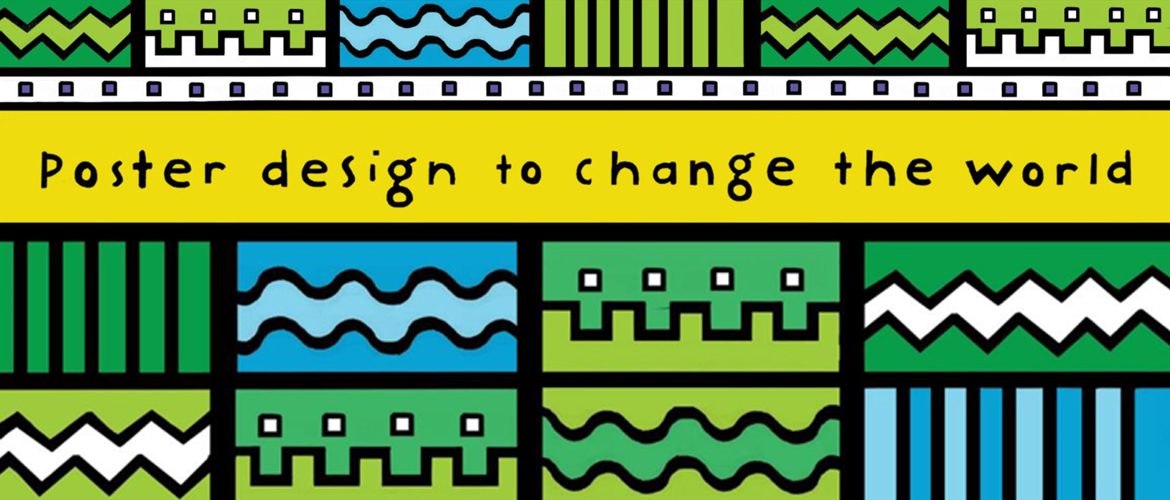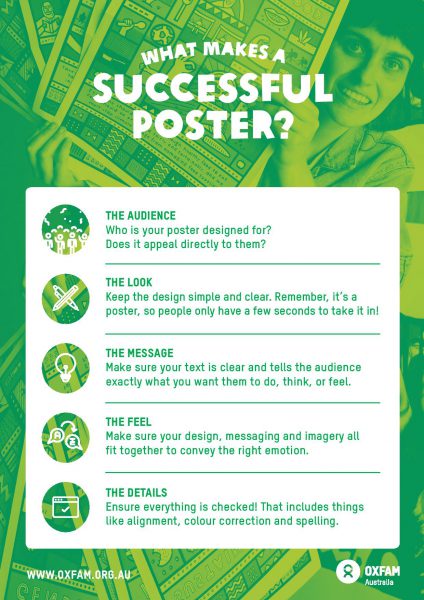Section 3 Part 3: Meeting a design Brief
Activity: Extending Steph Hughes’ campaign
The Oxfam campaigners needs you! Creating a strong campaign is about more than just posters. Read this campaign communications brief, outlining the ‘six goals to change the world’ campaign communication aims and objectives. Take particular note of:

- the primary and secondary audiences
- the desired look and feel
- the purpose
- the client’s likes and dislikes
- the deliverables
In your team, develop a strategy to meet the brief and communicate the ‘six goals to change the world’ to a much broader Australian audience.
You will need to pitch your strategy against the other class teams. How creative can you get with your persuasive presentation?
Remember, in the design world, a successful pitch will win a new client. In this challenge, you might consider ways to extend this campaign that moves beyond posters and educational resources. You could consider mocking up sample stickers, online ads, transport promotions, night projections, digitial advertisements, products, etc.

Hint:
When you present your ideas to the class, you might wish to show the class a range of successful campaigns that have targeted audiences through an array of promotional materials such as the Interbrand Rebranding Campaign for Alzheimers Australia.
You could also look at other Oxfam campaigns, such as National Close the Gap Day. (see image below for various campaign paraphernalia) and the ‘Don’t be a square’ poster campaign for Oxfam shops, which appeared in Tube stations, at bus stops, etc.

Student evaluation task: Design challenge
Student activity 1. “Four Goals to Change our Community” Design Challenge
Complete the following steps:
The brief: Design a series of four posters to change your local community for the better. You should start by defining four goals for change. You could take inspiration from Oxfam’s Six Goals to Change the World, but with the goals for the local community reflecting an understanding of the local area.
Handy hint: The goals might focus on areas/topics such as:
- the environment;
- access to resources;
- education;
- taking care of others; or
- other local social values and concerns.
You might look at council websites and in local press to find goals that reflect community needs.
The process: The posters must use illustration and reflect an understanding of contemporary poster design. You will need to decide on a common visual identity/theme for the four posters.
You can draft all plans in your art/design journals and create a template. This should provide consistency in the visual theme of the poster series, since it will determine where the illustrations go, where the text is placed and how these elements are combined.
If you are working in a group, you will need to discuss each other’s work and share ideas to ensure that the four posters reflect a common look and are the result of collaboration.
The pitch: When the plans for the posters are resolved and the template is agreed on, you can pitch your poster design to your class and teacher. Take any advice on board before finalising the series of posters using marker pencils, poster paints or any other 2D materials.
Student activity 2. Digital poster design challenge
Design a poster to change the world that uses digital imagery and Photoshop rather than illustration.
You might select one of Oxfam’s Six Goals to Change the World to focus on and outline the goal in your design journal/diary.
Remember: refer to the Oxfam Strategic Plan to understand the issues and complexities of the specific goal and the promise that Oxfam has made. The Oxfam website also has lots of case studies and information on global issues.
In planning your work, you might focus on taking your own simple photographic image that conveys a clear message to the audience. Plans should detail the layout for the poster including the placement of imagery and text. You should also consider the use of lighting and the composition and subject matter for your photo shoot. You need to be aware of symbolism in your choice of subject matter and also Oxfam’s desire to convey a positive message in each poster.
You can see examples of other students’ work here:
- Elin Matilda Andersson’s #feelswrong posters.
- Graphis Competitions “Design for Change” #feelswrong posters.
- Maria Fontenelle’s “Bubble n Squeak” food justice campaign.
- University of Technology, Sydney’s “Small change, big difference”





